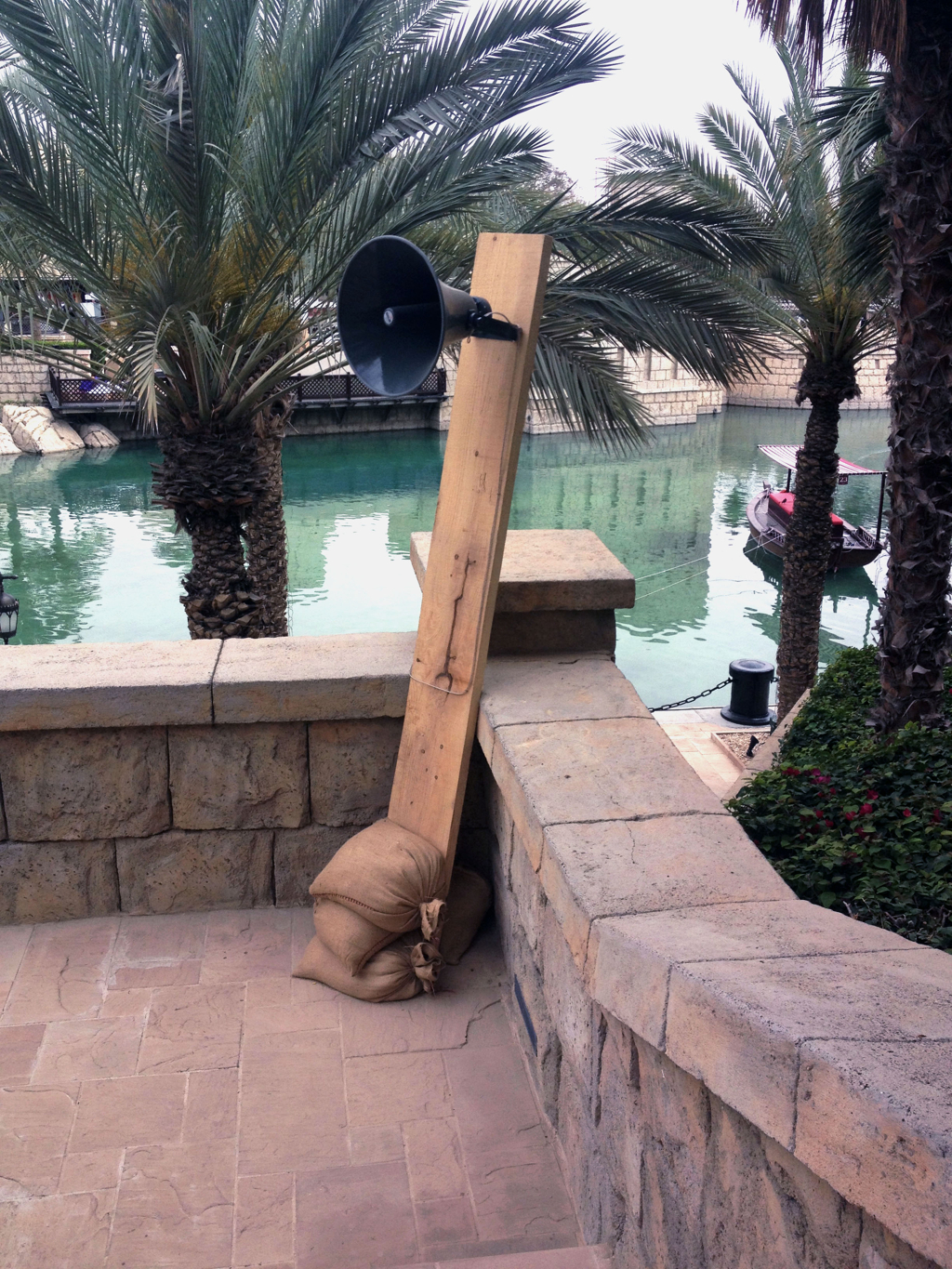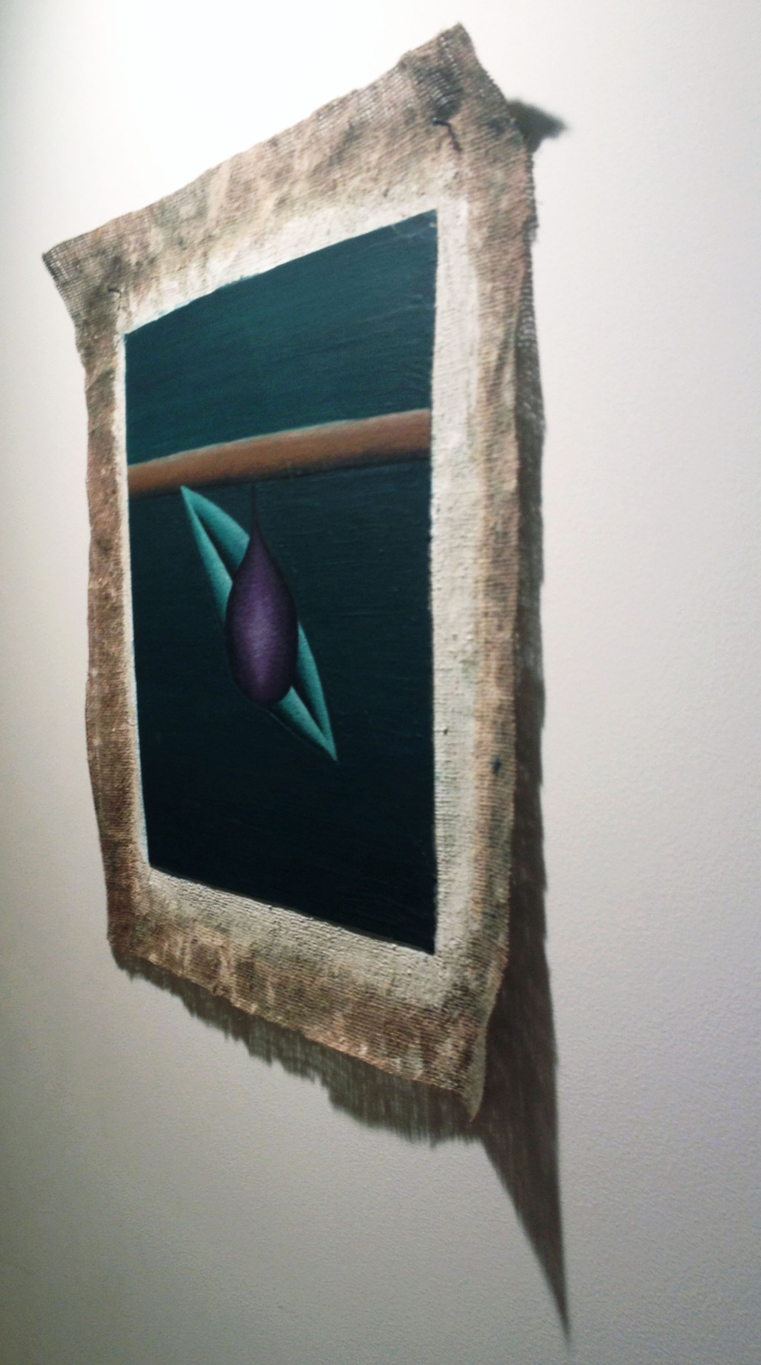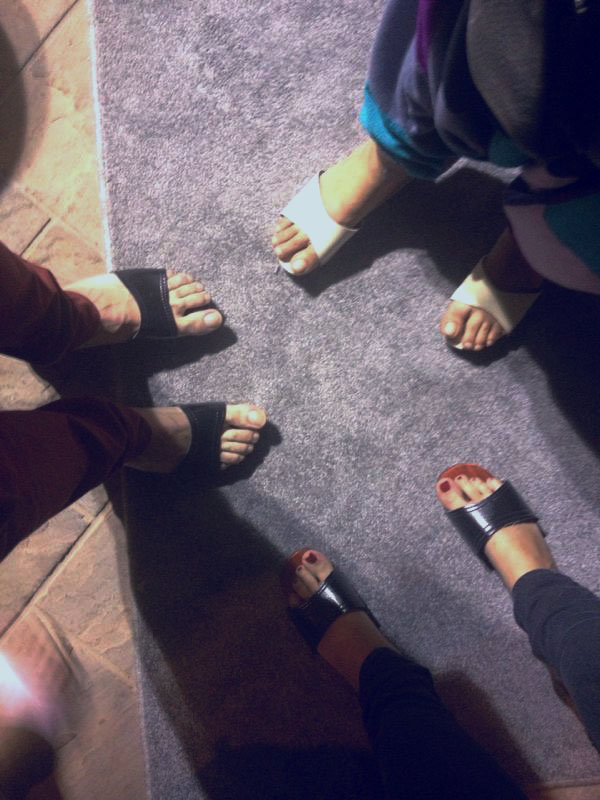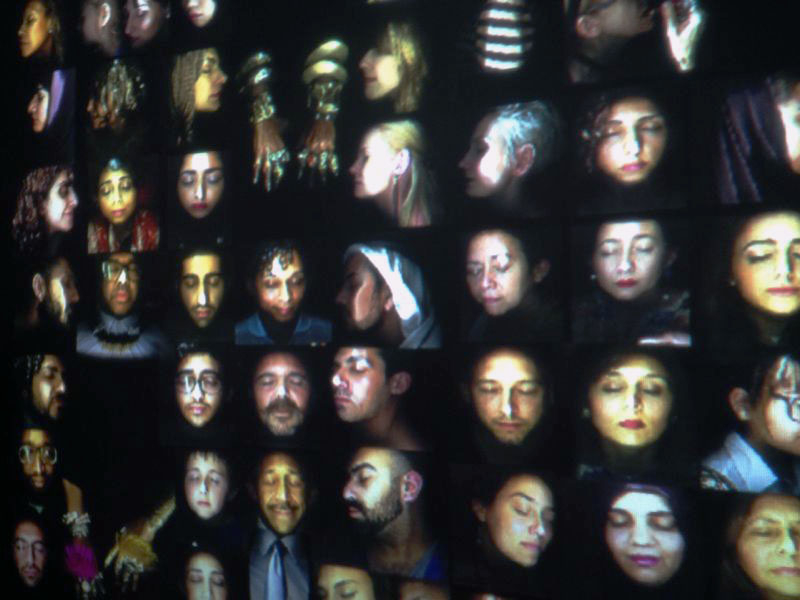A Walk-Through Art Dubai Projects 2014
Author & Photos ····· Rania Jaber
Published ······ Online, Apr 2014
Section ······· Art & Design
Published ······ Online, Apr 2014
Section ······· Art & Design
To intervene is to cut, disrupt the flow, to add or to perhaps
challenge a situation or conversation. The idea of “interventions” was
the theme for this year’s Art Dubai Projects, the part of Art Dubai that caters to the more interesting non-commercial and site-specific
commissioned works. Supported by Alserkal Avenue Arts District and Art
Salon, Art Dubai Projects works alongside a few organisations such as
Delfina Foundation, Tashkeel, A.i.R. Dubai (an annual residency
programme in Dubai). This year’s curator Fawz Kabra and Art Dubai
director Antonia Carver, invited a selection of 12 artists to
participate: Nadia Ayari, Youmna Chlala, Clark House Initiative,
Sunoj D, Maitha Demithan, Sara Al Haddad, Shuruq Harb, Amina Menia,
Maryam Al Qassimi, Mounira Al Solh and Hajra Waheed.
![]()
Sunoj D
According to Kabra, selected artists had to be well-established artists who were familiar with Dubai and willing to set up a site-specific intervention, and they had to be from the Middle East, North Africa, and South East Asia region. It was coincidental that the majority of artists who were invited to participate in interventions were women. Speaking to Kabra about this issue, she asserted that during a conversation she had with Art Dubai director Antonia Carver, they both expressed that it was about time the balance shifted towards women artists interrupting an art space. I couldn’t agree more.
Set in Madinat Jumeirah, the main entrance to Art Dubai was decorated with overgrown local shrubs in pots lining the main pathway into the fair. Visitors walking in were greeted with what they may have missed as the first intervention entitled The Desire Path by artist Youmna Chlala. According to Chlala, the entire path should have been adorned with the shrubs, to force walkers to create their own way into the art fair. Unfortunately, due to certain safety (or perhaps aesthetic concerns) the plants were placed to line the entrance instead, with leaves and soil falling off onto the carpets.
Wandering into the art fair, visitors who were interested in seeing the projects were guided into the bathrooms where the artist Nadia Ayari had placed two of her paintings in both women’s and men’s bathrooms respectively. Positioned facing the mirror, visitors were encouraged to interact with the paintings through the intimate setting of a bathroom. While fixing their hair or re-applying make-up, guests were able to integrate Ayari’s paintings into ‘selfie’ shots. Ayari wanted to hang her paintings in the last place expected. This was her interjection into the politics of viewing, which challenges how we look at art on white walls, but might perhaps fail to see what is right in front of our eyes or behind the bathroom mirror. Her work brings out questions of value, and the change in economic power we give to art works that are taken out of a gallery context.
![]()
Nadia Ayari
Moving on to the dark alluring studio of Maitha Demithan, the artist had a make-do photo booth set up where she was scanning people’s faces with an actual scanner! After scanning faces of visitors, she compiled a study of the various people who passed through the art fair. Guests who usually appear in flashy photographs in magazines rarely look as relaxed, natural as they did through Demithan’s scanned projection. Wandering outside, it was hard to miss the two large cauldrons emanating smoke into the warm Dubai air. Maryam al Qassimi’s ready made sculptures entitled Re:purpose signified the artist’s purpose to reclaim the space through traditional cultural ways of welcoming guests into a home by burning incense or bakhour. Through these overly dominating bakhour burners, she investigated the symbols of Emirati identity in an international art fair set in a fabricated setting, which according to the artist is fitting because Madinat Jumeirah claims to be an authentic representation of ancient Arabia.
Facing the bakhour sculptures on the waterfront were two stands filled with clogs akin to what one would find at a market place. Mounira Al Solh’s project Clogged is a playful intervention that invited guests to trade their designer shoes for Syrian bath or hammam clogs that the artist had commissioned craftsmen in Damascus to make. Al Solh wanted to challenge a few aspects of the art fair: first of all, clogs make a sound when worn and challenge the shoe styles of fair goers hence allowing visitors to put on a pair of modest attire and become part of a community. Second of all, she sought after the humanitarian need to empathise with others who were suffering, which is evidenced, in her connection to the Syrian crisis. Once personal shoes were exchanged for clogs, visitors participated in the affective memory of what was happening in a not so far, and not as glitzy, situation.
![]()
Mounira Al Solh
Walking towards the Mina A’Salam Hotel, visitors were confronted with rectangular blocks of grass and were invited to walk on them, turn them around or reposition the pieces. This was an extension of Chlala’s The Desire Path. She explained to me that her original idea was to place each rectangular piece on the path to hinder the flow of people, to create an obstruction that visitors were forced to notice, question and work their way around.
Drawn by the drone of voices coming from one of the speakers on the bottom staircase near Chlala’s installation piece, visitors were encouraged to edge closer and listen carefully to a voice coming out of a domineering megaphone. Walking up the staircase, there were two more megaphones all belting out three different voices counting in different languages: English, Arabic, and in Malayalam – the artist’s mother tongue. Equivalent to the cost of production of his intervention, Sunoj D counted $2,000 USD, in English; 7,400 UAE dirhams, in Arabic and 125,000 Indian rupees, in Malayalam. According to the artist, the act of counting numbers, which in Indian Rupees took him 40 hours to complete, was meditative and took on the character of a chant. It addressed the monetary attraction to Dubai that he had experienced from growing up in Kerala, India, and having witnessed the many immigrants who fled to work in Dubai.
![]()
Maitha Demithan
Overall, Art Projects Dubai provided a much-needed interruption from the dazzle and commercial exchanges between artists, gallery owners, and collectors. The commissioned projects provided a welcomed respite for creating critical criticism, making connections, generating transactions through dialogue and challenged how we interact with art works and spaces. This is what was precisely interesting about projects this year; the ways in which artists directed audiences, yet also needed them to participate and create their own journey through the art fair.
artdubai.ae

Sunoj D
According to Kabra, selected artists had to be well-established artists who were familiar with Dubai and willing to set up a site-specific intervention, and they had to be from the Middle East, North Africa, and South East Asia region. It was coincidental that the majority of artists who were invited to participate in interventions were women. Speaking to Kabra about this issue, she asserted that during a conversation she had with Art Dubai director Antonia Carver, they both expressed that it was about time the balance shifted towards women artists interrupting an art space. I couldn’t agree more.
Set in Madinat Jumeirah, the main entrance to Art Dubai was decorated with overgrown local shrubs in pots lining the main pathway into the fair. Visitors walking in were greeted with what they may have missed as the first intervention entitled The Desire Path by artist Youmna Chlala. According to Chlala, the entire path should have been adorned with the shrubs, to force walkers to create their own way into the art fair. Unfortunately, due to certain safety (or perhaps aesthetic concerns) the plants were placed to line the entrance instead, with leaves and soil falling off onto the carpets.
Wandering into the art fair, visitors who were interested in seeing the projects were guided into the bathrooms where the artist Nadia Ayari had placed two of her paintings in both women’s and men’s bathrooms respectively. Positioned facing the mirror, visitors were encouraged to interact with the paintings through the intimate setting of a bathroom. While fixing their hair or re-applying make-up, guests were able to integrate Ayari’s paintings into ‘selfie’ shots. Ayari wanted to hang her paintings in the last place expected. This was her interjection into the politics of viewing, which challenges how we look at art on white walls, but might perhaps fail to see what is right in front of our eyes or behind the bathroom mirror. Her work brings out questions of value, and the change in economic power we give to art works that are taken out of a gallery context.

Nadia Ayari
Moving on to the dark alluring studio of Maitha Demithan, the artist had a make-do photo booth set up where she was scanning people’s faces with an actual scanner! After scanning faces of visitors, she compiled a study of the various people who passed through the art fair. Guests who usually appear in flashy photographs in magazines rarely look as relaxed, natural as they did through Demithan’s scanned projection. Wandering outside, it was hard to miss the two large cauldrons emanating smoke into the warm Dubai air. Maryam al Qassimi’s ready made sculptures entitled Re:purpose signified the artist’s purpose to reclaim the space through traditional cultural ways of welcoming guests into a home by burning incense or bakhour. Through these overly dominating bakhour burners, she investigated the symbols of Emirati identity in an international art fair set in a fabricated setting, which according to the artist is fitting because Madinat Jumeirah claims to be an authentic representation of ancient Arabia.
Facing the bakhour sculptures on the waterfront were two stands filled with clogs akin to what one would find at a market place. Mounira Al Solh’s project Clogged is a playful intervention that invited guests to trade their designer shoes for Syrian bath or hammam clogs that the artist had commissioned craftsmen in Damascus to make. Al Solh wanted to challenge a few aspects of the art fair: first of all, clogs make a sound when worn and challenge the shoe styles of fair goers hence allowing visitors to put on a pair of modest attire and become part of a community. Second of all, she sought after the humanitarian need to empathise with others who were suffering, which is evidenced, in her connection to the Syrian crisis. Once personal shoes were exchanged for clogs, visitors participated in the affective memory of what was happening in a not so far, and not as glitzy, situation.

Mounira Al Solh
Walking towards the Mina A’Salam Hotel, visitors were confronted with rectangular blocks of grass and were invited to walk on them, turn them around or reposition the pieces. This was an extension of Chlala’s The Desire Path. She explained to me that her original idea was to place each rectangular piece on the path to hinder the flow of people, to create an obstruction that visitors were forced to notice, question and work their way around.
Drawn by the drone of voices coming from one of the speakers on the bottom staircase near Chlala’s installation piece, visitors were encouraged to edge closer and listen carefully to a voice coming out of a domineering megaphone. Walking up the staircase, there were two more megaphones all belting out three different voices counting in different languages: English, Arabic, and in Malayalam – the artist’s mother tongue. Equivalent to the cost of production of his intervention, Sunoj D counted $2,000 USD, in English; 7,400 UAE dirhams, in Arabic and 125,000 Indian rupees, in Malayalam. According to the artist, the act of counting numbers, which in Indian Rupees took him 40 hours to complete, was meditative and took on the character of a chant. It addressed the monetary attraction to Dubai that he had experienced from growing up in Kerala, India, and having witnessed the many immigrants who fled to work in Dubai.

Maitha Demithan
Overall, Art Projects Dubai provided a much-needed interruption from the dazzle and commercial exchanges between artists, gallery owners, and collectors. The commissioned projects provided a welcomed respite for creating critical criticism, making connections, generating transactions through dialogue and challenged how we interact with art works and spaces. This is what was precisely interesting about projects this year; the ways in which artists directed audiences, yet also needed them to participate and create their own journey through the art fair.
artdubai.ae
Rania
Jaber is a PhD student in Anthropology and Art History. Her research
looks at women artists in the Lebanese diaspora interested in ideas of
cultural translation, gender and language.
